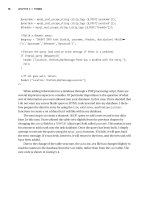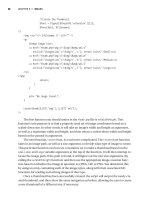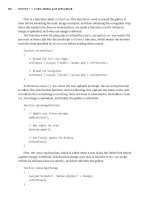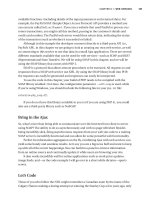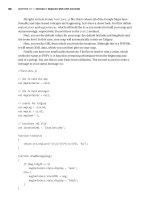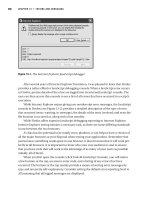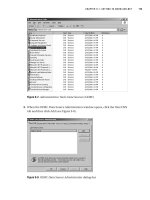Beginning Ajax with PHP From Novice to Professional phần 5 docx
Bạn đang xem bản rút gọn của tài liệu. Xem và tải ngay bản đầy đủ của tài liệu tại đây (400.76 KB, 20 trang )
$yourname = mysql_real_escape_string (strip_tags ($_POST['yourname']));
$yourtask = mysql_real_escape_string (strip_tags ($_POST['yourtask']));
$thedate = mysql_real_escape_string (strip_tags ($_POST['thedate']));
//Build a dynamic query.
$myquery = "INSERT INTO task (taskid, yourname, thedate, description) VALUES➥
('0','$yourname','$thedate','$yourtask')";
//Execute the query (and send an error message if there is a problem).
if (!mysql_query ($myquery)){
header ("Location: theform.php?message=There was a problem with the entry.");
exit;
}
//If all goes well, return.
header ("Location: theform.php?message=success");
?>
When adding information to a database through a PHP processing script, there are
several important aspects to consider. Of particular importance is the question of what
sort of information you want allowed into your database. In this case, I have decided that
I do not want any excess blank space or HTML code inserted into my database. I there-
fore prepare the data for entry by using the
trim, addslashes, and htmlspecialchars
functions to create a set of data that I will like within my database.
The next step is to create a dynamic
INSERT query to add a new record to my data-
base. In this case, I have altered the table very slightly from the previous chapter by
changing the
userid field to a TINYTEXT (data type) field called yourname. This makes it easy
for anyone to add a task into the task database. Once the query has been built, I simply
attempt to execute the query using the
mysql_query function. If it fails, it will pass back
the error message. If it succeeds, however, it will return to the form, and the new task will
have been added.
Due to the change of the table structure, the
autocomp.php file has changed slightly to
read the names in the database from the
task table, rather than from the user table. The
new code is shown in Listing 5-4.
CHAPTER 5 ■ FORMS78
6676CH05.qxd 9/27/06 12:12 PM Page 78
Listing 5-4. The Code That Will Pop Up As an Auto-Complete Listing (autocomp.php)
<?php
//autocomp.php
//Add in our database connector.
require_once ("dbconnector.php");
//And open a database connection.
$db = opendatabase();
$myquery = "SELECT DISTINCT(yourname) AS yourname FROM task WHERE➥
yourname LIKE LOWER('%" . mysql_real_escape_string($_GET['sstring']) . "%')➥
ORDER BY yourname ASC";
if ($userquery = mysql_query ($myquery)){
if (mysql_num_rows ($userquery) > 0){
?>
<div style="background: #CCCCCC; border-style: solid; border-width: 1px;➥
border-color: #000000;">
<?php
while ($userdata = mysql_fetch_array ($userquery)){
?><div style="padding: 4px; height: 14px;" onmouseover="➥
this.style.background
= '#EEEEEE'" onmouseout="this.style.background = '#CCCCCC'" ➥
onclick="setvalue ('<?php echo $userdata['yourname']; ?>')">➥
<?php echo $userdata['yourname']; ?></div><?php
}
?>
</div>
<?php
}
} else {
echo mysql_error();
}
?>
CHAPTER 5 ■ FORMS 79
6676CH05.qxd 9/27/06 12:12 PM Page 79
Now that the autocomp.php field is reading from the task table, you can add as many
tasks as you want, and the system will make it nice and easy to add more. The results are
shown in Figure 5-2; first before adding the new user (and task) and then after the new
user has been entered.
Figure 5-2. A before-and-after example of adding records into the database using Ajax-
based form submission
Form Validation
Form validation (well, validation period) is what I believe separates the slackers from the
true development professionals. Your application will only run as well as the code that
implements it, and such success is partly defined by being aware of what errors could
potentially occur as well as how to deal with them should problems arise. In the develop-
ment world, handling errors and unplanned actions is called validation.
There are two ways to validate input: client-side and server-side. Naturally, as you
might imagine, one is handled by your client-side language (in this case JavaScript) and
the other is handled by your server-side language (PHP, in this case). This is one of the
cases in coding that I believe redundancy is not only useful, but highly necessary. In
order to have a fully functional, non-crashing web application, it is important to validate
for a proper submission from the user. If users witnesses bugs or crashes, they lose trust
in your product. If users lose trust in a product, they will likely not use it.
CHAPTER 5 ■ FORMS80
6676CH05.qxd 9/27/06 12:12 PM Page 80
Consider the current example, for instance. It works great if the user submits their
name and task, but what if they fail to do so? You would end up with blank entries in your
database that could potentially cause problems with your system. Remember how I
talked about building your JavaScript to allow for some validation? Well, it is time to put
that structure to use. Let’s have a look at the client-side validation first.
//functions.js
function trim (inputString) {
// Removes leading and trailing spaces from the passed string. Also removes
// consecutive spaces and replaces them with one space. If something besides
// a string is passed in (null, custom object, etc.), then return the input.
if (typeof inputString != "string") { return inputString; }
var retValue = inputString;
var ch = retValue.substring(0, 1);
while (ch == " ") { // Check for spaces at the beginning of the string
retValue = retValue.substring(1, retValue.length);
ch = retValue.substring(0, 1);
}
ch = retValue.substring(retValue.length-1, retValue.length);
while (ch == " ") { // Check for spaces at the end of the string
retValue = retValue.substring(0, retValue.length-1);
ch = retValue.substring(retValue.length-1, retValue.length);
}
while (retValue.indexOf(" ") != -1) {➥
// Note there are two spaces in the string
// Therefore look for multiple spaces in the string
retValue = retValue.substring(0, retValue.indexOf(" ")) +➥
retValue.substring(retValue.indexOf(" ")+1, retValue.length);➥
// Again, there are two spaces in each of the strings
}
return retValue; // Return the trimmed string back to the user
} // Ends the "trim" function
The first new function to note is the trim function. I don’t want to dwell on this func-
tion too much, as it is quite intricate in its nature when only its actual functionality is
important. Suffice to say that the
trim function does what its server-side brother does—it
removes all blank characters from the front and end of a string. While PHP has its own
library of functions to use, you must sadly code in anything you want to use for JavaScript
validation. The goal of this function is to ensure that you are testing for blank strings that
are not simply filled with blank spaces.
CHAPTER 5 ■ FORMS 81
6676CH05.qxd 9/27/06 12:12 PM Page 81
//Function to validate the addtask form.
function validatetask (thevalue, thename){
var nowcont = true;
if (thename == "yourname"){
if (trim (thevalue) == ""){
document.getElementById("themessage").innerHTML = ➥
"You must enter your name.";
document.getElementById("newtask").yourname.focus();
nowcont = false;
}
}
if (nowcont == true){
if (thename == "yourtask"){
if (trim (thevalue) == ""){
document.getElementById("themessage").innerHTML = ➥
"You must enter a task.";
document.getElementById("newtask").yourtask.focus();
nowcont = false;
}
}
}
return nowcont;
}
This function is the one that will be called as the getformvalues function loops
through the form element. It checks which field you want to validate (via the
thename
value), and then it checks to make sure that the field is not empty (via the thevalue ele-
ment). If the field does happen to be empty, the function will return a
false value and tell
the system to put the focus on the empty form element.
var aok;
//Functions to submit a form.
function getformvalues (fobj, valfunc){
var str = "";
aok = true;
var val;
CHAPTER 5 ■ FORMS82
6676CH05.qxd 9/27/06 12:12 PM Page 82
//Run through a list of all objects contained within the form.
for(var i = 0; i < fobj.elements.length; i++){
if(valfunc) {
if (aok == true){
val = valfunc (fobj.elements[i].value,fobj.elements[i].name);
if (val == false){
aok = false;
}
}
}
str += fobj.elements[i].name + "=" + escape(fobj.elements[i].value) + "&";
}
//Then return the string values.
return str;
}
As you can see, the getformvalues function has been modified significantly to
account for the added validation. First off, a
valfunc function is passed in to the script
that will validate the input (in this case, you are using the
validatetask validation script).
Then, for every type of value that you want to validate against (in this case,
text and
textarea values), you call the validation function and pass in the name and value to be
used. If the system returns a
false value from any of the types, the form will not submit.
The system uses the
aok variable to determine whether an XMLHttpRequest request should
be made. If it is set to
false, then that means a validation error has occurred, and the
problem must be rectified before the script will be allowed to progress.
function submitform (theform, serverPage, objID, valfunc){
var file = serverPage;
var str = getformvalues(theform,valfunc);
//If the validation is ok.
if (aok == true){
obj = document.getElementById(objID);
processajax (serverPage, obj, "post", str);
}
}
The changes that have been done to the submitform function are rather self-
explanatory. The
submitform function now accepts the valfunc variable (passed in from
the
onclick event handler within the theform.php file; shown in Listing 5-5) and passes
it to the
getformvalues function. The processajax function will now only make the request
to the server once the
aok variable is set to true (thus allowing the validation to stay in
effect until there is a completed form).
CHAPTER 5 ■ FORMS 83
6676CH05.qxd 9/27/06 12:12 PM Page 83
Listing 5-5. A Revised Version of the Form Script That Is Shown When a Date on the
Calendar Is Clicked (theform.php)
<?php
//theform.php
?>
<div style="padding: 10px;">
<div id="themessage">
<?php
if (isset ($_GET['message'])){
echo $_GET['message'];
}
?>
</div>
<form action="process_task.php" method="post" id="newtask" name="newtask">
Your Name<br />
<input name="yourname" id="yourname" style="width: 150px; height: 16px;"➥
type="text" value="" onkeypress="autocomplete(this.value, event)" /><br />
Your Task<br />
<textarea style="height: 80px;" name="yourtask" id="yourtask">➥
</textarea><br />
<input type="hidden" name="thedate" value="<?php echo $_GET['thedate']; ?>" />
<input type="button" value="Submit" onclick="submitform➥
(document.getElementById('newtask'),'process_task.php','createtask', ➥
validatetask); return false;" />
<div align="right"><a href="javascript:closetask()">close</a></div>
</form>
</div>
The only real change to the theform.php file is that you must now pass the
validatetask function name in with the submitform function call. This makes the
submitform function rather portable by allowing you to specify which validation script
to use.
Now that the client-side validation is done, have a look at the redundant validation
in the form of server-side scripting in PHP, shown in Listing 5-6.
CHAPTER 5 ■ FORMS84
6676CH05.qxd 9/27/06 12:12 PM Page 84
Listing 5-6. A Revised Version of the Task-Submission Script (process_task.php)
<?php
//process_task.php
//Create a connection to the database.
require_once ("dbconnector.php");
opendatabase();
//Validate.
if (trim ($_POST['yourname']) == ""){
header ("Location: theform.php?message=Please enter your name.");
exit;
}
if (trim ($_POST['yourtask']) == ""){
header ("Location: theform.php?message=Please enter a task.");
exit;
}
//Now, prepare data for entry into the database.
$yourname = mysql_real_escape_string (strip_tags ($_POST['yourname']));
$yourtask = mysql_real_escape_string (strip_tags ($_POST['yourtask']));
$thedate = mysql_real_escape_string (strip_tags ($_POST['thedate']));
//Build a dynamic query.
$myquery = "INSERT INTO task (taskid, yourname, thedate, description) VALUES➥
('0','$yourname','$thedate','$yourtask')";
//Execute the query (and send an error message if there is a problem).
if (!mysql_query ($myquery)){
header ("Location: theform.php?message=There was a problem with the entry.");
exit;
}
//If all goes well, return.
header ("Location: theform.php?message=success");
?>
CHAPTER 5 ■ FORMS 85
6676CH05.qxd 9/27/06 12:12 PM Page 85
The nice thing about validation from a server-side perspective is that programming
languages such as PHP have a very nice selection of functions ready for usage (whereas in
JavaScript, you would have to include them). Note the validation statements, which take
effect before you get into the meat and potatoes of the script. You test for a non-empty
string (via the
trim function) and return to the form with an error message if you have no
submitted values. The
exit function cuts the script off if there is a problem, and the user
gets to finish filling in the form properly.
As you can see, validation may involve a little more work, but it will allow you to sleep
better at night knowing that your scripts are safe from a wide range of problems, and
that your users will be able to get the most out of your hard work and commitment (see
Figure 5-3).
Figure 5-3. Validation: a true developer’s friend
Summary
Well, another piece of the Ajax puzzle has been put into place. As you continue through
this book, you will continue to steadily build upon the core ideas. Now that you have form
submission, dynamic server requests, and client-side JavaScript under wraps, you have a
rather large repertoire of knowledge that you can use to perform some valuable functions.
By allowing the user a way to interact with both your client-side and server-side tech-
nologies, and then confirming the data being passed to each, you have opened a door
that will allow you to move ahead with some of the more fun and advanced Ajax method-
ologies. There is one last set of functionality that should be discussed before you are
ready to start doling out some intriguing applications: images.
CHAPTER 5 ■ FORMS86
6676CH05.qxd 9/27/06 12:12 PM Page 86
Images
Isuppose that it goes without saying that one of the more annoying, yet necessary,
aspects of browsing a web site using a slow Internet connection is waiting for images to
load. While text-based web sites can display instantaneously (or seemingly so) on any
Internet connection, images must be downloaded in order to be viewable. With the
advent of high-speed Internet, this issue has become less of a problem, but images still
require time to display. Nonetheless, images are indispensable to the user experience,
and therefore, as web developers, we’re tasked with minimizing the negative aspects of
image loading.
Thankfully, through concepts such as Ajax and scripting languages like PHP, we now
have a much more robust set of tools with which to deal with imaging. Through Ajax, we
can dynamically load and display images without the rest of the page having to reload,
which speeds up the process considerably. We also have more control over what the user
sees while the screen or image loads. Users are generally understanding of load times,
provided that you let them know what is happening. Through Ajax and a little PHP magic,
we can help the user’s experience be as seamless and enjoyable as possible.
Throughout this chapter, I will be going through the basics of uploading, manipulat-
ing, and dynamically displaying images using PHP and Ajax.
Uploading Images
I suppose it is necessary to bring a little bad news to Ajax at this point; it is not possible
to process a file upload through the
XMLHttpRequest object. The reason for this is that
JavaScript has no access to your computer’s file system. While this is somewhat disap-
pointing, there are still ways to perform Ajax-like functionality for this without making
use of the
XMLHttpRequest object. Clever developers have discovered that you can use
hidden iframes to post a form request, thereby allowing for a file upload without a com-
plete page refresh (although you might see a bit of a screen flicker).
By setting the iframe’s CSS
display property to none, the element is present on the
page to be utilized by the upload form, but not visible to the end user. By assigning a
name
to the iframe tag, you can use the target attribute in the form tag to post the request to the
87
CHAPTER 6
6676CH06.qxd 9/27/06 11:55 AM Page 87
hidden iframe. Once you have the iframe configured, you can perform any uploads you
like, and then use Ajax to perform any extra functionality. Consider the following exam-
ple, which will allow you to upload an image to a folder of your specification. Consider
the code in Listing 6-1, which will allow you to create the application shown in Figure 6-1.
Figure 6-1. An Ajax-enabled file upload system that uses hidden iframes to hide the upload
Listing 6-1. The Code to Create a Form with a Hidden Iframe for Processing
(sample6_1.html)
<! sample6_1.html >
<!DOCTYPE html PUBLIC "-//W3C//DTD XHTML 1.0 Transitional//EN"➥
" /><html xmlns=" /><head>
<title>Sample 6_1</title>
<meta http-equiv="Content-Type" content="text/html; charset=iso-8859-1" />
<link rel="stylesheet" type="text/css" href="style.css" />
<script type="text/javascript" src="xmlhttp.js"></script>
<script type="text/javascript" src="functions.js"></script>
</head>
<body>
<div id="showimg"></div>
<form id="uploadform" action="process_upload.php" method="post"➥
enctype="multipart/form-data" target="uploadframe"➥
onsubmit="uploadimg(this); return false">
Upload a File:<br />
<input type="file" id="myfile" name="myfile" />
<input type="submit" value="Submit" />
<iframe id="uploadframe" name="uploadframe" src="process_upload.php"➥
class="noshow"></iframe>
</form>
</body>
</html>
Listing 6-1 creates the groundwork and user interface for the application. Here, you
will notice the form (with the
file element) and the iframe it will be posting the request
CHAPTER 6 ■ IMAGES88
6676CH06.qxd 9/27/06 11:55 AM Page 88
into. Note the noshow class, which is set up within the head tag of your document. The
noshow class is what will make your iframe effectively invisible.
In order to actually process the upload, you are using a bit of Ajax-enabled
JavaScript. The JavaScript to perform the upload can be found within the
functions.js
file, and is a function called uploadimg. This function is called when the submit button is
clicked.
//functions.js
function uploadimg (theform){
//Submit the form.
theform.submit();
}
For now, this file contains only one function (uploadimg), which will simply be used
to submit your form; but as you build upon this example throughout the chapter, it will
become a more crucial element in building a full Ajax structure. Once the form submits,
the following PHP file (loaded into the iframe) will handle the actual file upload. Consider
the PHP script in Listing 6-2.
Listing 6-2. The PHP Code Required to Upload the Image (process_upload.php)
<?php
//process_upload.php
//Allowed file MIME types.
$allowedtypes = array ("image/jpeg","image/pjpeg","image/png","image/gif");
//Where we want to save the file to.
$savefolder = "images";
//If we have a valid file
if (isset ($_FILES['myfile'])){
//Then we need to confirm it is of a file type we want.
if (in_array ($_FILES['myfile']['type'], $allowedtypes)){
//Then we can perform the copy.
if ($_FILES['myfile']['error'] == 0){
$thefile = $savefolder . "/" . $_FILES['myfile']['name'];
if (!move_uploaded_file ($_FILES['myfile']['tmp_name'], $thefile)){
echo "There was an error uploading the file.";
} else {
//Signal the parent to load the image.
?>
CHAPTER 6 ■ IMAGES 89
6676CH06.qxd 9/27/06 11:55 AM Page 89
<!DOCTYPE html PUBLIC "-//W3C//DTD XHTML 1.0 Transitional//EN"➥
" /><html xmlns=" /><head>
<script type="text/javascript" </head>
<body onload="doneloading (parent,'<?=$thefile?>')">
<img src="<?=$thefile?>" />
</body>
</html>
<?php
}
}
}
}
?>
In this PHP code, you first create two variables that you will use to determine what
type of file you want uploaded and where you want to put it. The
$allowedtypes array con-
tains a listing of MIME types that you want to allow. A file’s MIME type is a string that is
used to denote the type of data the file contains. In this case, we are only allowing images
of type JPEG, GIF, and PNG.
You will be saving your uploaded images to a folder on the web server, which means
you need a directory that is writable by the web server. Listing 6-2 specified
images as the
upload directory (indicated by the
$savefolder variable). To make the folder writable by
the web server, you can use your FTP client, or if you have command-line access, you can
use the
chmod command (chmod 777 /path/to/images).
To write the uploaded image to the target folder, you use the function
move_uploaded_
file. This PHP function will retrieve the image and move it to the designated location.
Additionally, it ensures that the file in question was in fact uploaded via the script. It
returns a
false value if anything goes wrong, so it is important to use code to monitor
that fact and react accordingly. If all goes well, voilà—you will have a brand-spanking
new image uploaded to the folder of your choice, with almost no visible processing to
the user. By making use of the
onload event, you can then trigger a JavaScript function to
pass the file name that has been uploaded to the parent frame (the one that initiated the
upload). The
onload event comes in handy for this because it lets you determine when the
image has finished its upload to the server. The next section will show how to the display
the uploaded image.
CHAPTER 6 ■ IMAGES90
6676CH06.qxd 9/27/06 11:55 AM Page 90
Displaying Images
So, were you beginning to wonder when you might get into the whole Ajax concept of this
chapter? Well, you’re now ready for it.
Once you upload an image to the server, it might be nice to actually display it. You
can do this by firing an Ajax request after you have finished the image upload. Consider
the following functions added to the
xmlhttp.js (Listing 6-3) and functions.js (Listing 6-4)
scripts.
Listing 6-3. The JavaScript Code Required to Perform Ajax Requests (xmlhttp.js)
//xmlhttp.js
//Function to create an XMLHttp Object.
function getxmlhttp (){
//Create a boolean variable to check for a valid Microsoft ActiveX instance.
var xmlhttp = false;
//Check if we are using Internet Explorer.
try {
//If the JavaScript version is greater than 5.
xmlhttp = new ActiveXObject("Msxml2.XMLHTTP");
} catch (e) {
//If not, then use the older ActiveX object.
try {
//If we are using Internet Explorer.
xmlhttp = new ActiveXObject("Microsoft.XMLHTTP");
} catch (E) {
//Else we must be using a non-Internet Explorer browser.
xmlhttp = false;
}
}
// If we are not using IE, create a JavaScript instance of the object.
if (!xmlhttp && typeof XMLHttpRequest != 'undefined') {
xmlhttp = new XMLHttpRequest();
}
CHAPTER 6 ■ IMAGES 91
6676CH06.qxd 9/27/06 11:55 AM Page 91
return xmlhttp;
}
//Function to process an XMLHttpRequest.
function processajax (obj, serverPage){
//Get an XMLHttpRequest object for use.
var theimg;
xmlhttp = getxmlhttp ();
xmlhttp.open("GET", serverPage);
xmlhttp.onreadystatechange = function() {
if (xmlhttp.readyState == 4 && xmlhttp.status == 200) {
document.getElementById(obj).innerHTML = xmlhttp.responseText;
}
}
xmlhttp.send(null);
}
Listing 6-4. The JavaScript Code Required to Load in the Uploaded Image (functions.js)
//functions.js
//Function to determine when the process_upload.php file has finished executing.
function doneloading(theframe,thefile){
var theloc = "showimg.php?thefile=" + thefile
theframe.processajax ("showimg",theloc);
}
As you can see, you’re using the same functionality that I first went over in the last
few chapters, and you’ll now use it to load the recently uploaded image into your web
page dynamically and without a screen refresh. The
uploadimg function will still perform
your form submission, but it is now coupled with a function called
doneuploading, which
will fire once the
process_upload.php script has finished uploading the image (determined
by the
onload event). The doneuploading function takes the parent frame of the hidden
iframe and the file name as arguments. It then uses Ajax to dynamically load the image
into the specified element of the parent frame.
Listing 6-5 then shows how the
showimg.php file receives the file name and displays
the image.
CHAPTER 6 ■ IMAGES92
6676CH06.qxd 9/27/06 11:55 AM Page 92
Listing 6-5. The PHP Code Required to Show the Passed-In Image File Name (showimg.php)
<?php
//showimg.php
$file = $_GET['thefile'];
//Check to see if the image exists.
if (!is_file($file) || !file_exists($file))
exit;
?>
<img src="<?= $file ?>" alt="" />
The showimg.php file is responsible for showing you the image that has been
uploaded. It does this by receiving the name of the file that has recently been uploaded
through the Ajax-based file upload code. The
doneloading function that is in functions.js
passes the file name to the showimg.php file (via Ajax). The showimg.php file then checks to
ensure that a valid file has been passed to it (via the
is_file and file_exists functions).
If a valid file is found, then the script shows it, as shown in Figure 6-2.
Figure 6-2. Ahh, it looks so much nicer with the display.
CHAPTER 6 ■ IMAGES 93
6676CH06.qxd 9/27/06 11:55 AM Page 93
Loading Images
Unfortunately, while the script knows about the delay and the image loading, the user
will have no idea what is going on. Fortunately, using Ajax, you can help inform the
user as to what is happening. While the first I had seen of the “Loading . . .” text was in
Google’s Gmail application, it has since appeared in many other Ajax-driven applications.
Thankfully, through the use of the
innerHTML property, it is quite simple to display a load-
ing message to the user while the
showimg.php script is performing its functionality. Have
a look at Listing 6-6, which shows the
uploadimg function—this time including a call to
setStatus, which is a new function that writes a status message to the HTML element of
your choice.
Listing 6-6. The Changes to the uploadimg Function (functions.js)
function uploadimg (theform){
//Submit the form.
theform.submit();
//Then display a loading message to the user.
setStatus ("Loading ","showimg");
}
//Function to set a loading status.
function setStatus (theStatus, theObj){
obj = document.getElementById(theObj);
if (obj){
obj.innerHTML = "<div class=\"bold\">" + theStatus + "</div>";
}
}
Here, you have created a function called setStatus, which takes as arguments the
message and the element that you wish to load the message into. By making use of this
function, you create a means to keep the user informed as to what’s going on. Coding
Ajax applications is all about making the user feel secure about what’s happening. Now
when you upload an image, you will see a loading message while waiting for the script to
finish processing—similar to Figure 6-3.
Figure 6-3. Loading, loading, loading; keep those files a-loading.
CHAPTER 6 ■ IMAGES94
6676CH06.qxd 9/27/06 11:55 AM Page 94
Dynamic Thumbnail Generation
A very nice feature to put into any web site is the automatically generated thumbnail.
This can come in handy when creating such advanced software as content management
systems and photo galleries. PHP possesses a nice range of tools to resize images, but
the problem is always that of load times and how the page must refresh to generate the
thumbnail. In this next example, you’ll combine all you’ve learned in this chapter to
make PHP and Ajax work for you. You’ll create a thumbnail-generating mechanism that
will allow a file upload and then give the user the ability to resize the image on the fly.
Take a look at Listing 6-7 and consider the changes to the
showimg.php file.
Listing 6-7. The Changes Made to Accommodate a Thumbnail-Generation Script
(showimg.php)
<?php
//showimg.php
$file = $_GET['thefile'];
//Check to see if the image exists.
if (!is_file($file) || !file_exists($file))
exit;
?>
<img <p>
Change Image Size:
<a href="thumb.php?img=<?= $file ?>&sml=s"
onclick="changesize('<?= $file ?>','s'); return false;">Small</a>
<a href="thumb.php?img=<?= $file ?>&sml=m"
onclick="changesize('<?= $file ?>','m'); return false;">Medium</a>
<a href="thumb.php?img=<?= $file ?>&sml=l"
onclick="changesize('<?= $file ?>','l'); return false;">Large</a>
</p>
Here, the code has added a simple menu below the outputted image, allowing you to
display the image in three different sizes. Each link calls the
changesize function, which
takes as arguments the image path and a designated size. When the link is clicked, the
changesize function will invoke and thus create a thumbnail of the current image according
to the size requested, and then use Ajax to load in the image dynamically. The
changesize
function is shown in Listing 6-8.
CHAPTER 6 ■ IMAGES 95
6676CH06.qxd 9/27/06 11:55 AM Page 95
Listing 6-8. The Function to Invoke the Thumbnail-Generation Script via Ajax (functions.js)
function changesize (img, sml){
//Then display a loading message to the user.
theobj = document.getElementById("showimg");
if (theobj){
setStatus ("Loading ","showimg");
var loc = "thumb.php?img=" + img + "&sml=" + sml;
processajax ("showimg",loc);
}
}
You use the functionality from the preceding example to let the user know that you
are about to load a new image. When the Ajax request finishes, the loading message will
disappear. The
changesize function merely sends an Ajax request to the server and loads
thumb.php into your showimg div wrapper. Consider the thumb.php code in Listing 6-9,
which will create your thumbnail and display it on the screen.
Listing 6-9. The PHP Code to Create a Thumbnail Based on an Image Name Passed In by
Ajax (thumb.php)
<?php
//thumb.php
function setWidthHeight($width, $height, $maxWidth, $maxHeight)
{
$ret = array($width, $height);
$ratio = $width / $height;
if ($width > $maxWidth || $height > $maxHeight) {
$ret[0] = $maxWidth;
$ret[1] = $ret[0] / $ratio;
if ($ret[1] > $maxHeight) {
$ret[1] = $maxHeight;
$ret[0] = $ret[1] * $ratio;
}
}
return $ret;
}
CHAPTER 6 ■ IMAGES96
6676CH06.qxd 9/27/06 11:55 AM Page 96
//A function to change the size of an image.
function createthumb($img, $size = "s")
{
//First, check for a valid file.
if (is_file($img)) {
//Now, get the current file size.
if ($cursize = getimagesize ($img)) {
//Then, based on the sml variable, find the new size we want.
$sizes = array("s" => 100, "m" => 300, "l" => 600);
if (!array_key_exists($size, $sizes))
$size = "s";
$newsize = setWidthHeight($cursize[0],
$cursize[1],
$sizes[$size],
$sizes[$size]);
//Now that we have the size constraints, let's find the file type.
$thepath = pathinfo ($img);
//Set up our thumbnail.
$dst = imagecreatetruecolor ($newsize[0],$newsize[1]);
//Make a file name.
$filename = str_replace (".".$thepath['extension'], "", $img);
$filename = $filename . "_th" . $size . "." . $thepath['extension'];
$types = array('jpg' => array('imagecreatefromjpeg', 'imagejpeg'),
'jpeg' => array('imagecreatefromjpeg', 'imagejpeg'),
'gif' => array('imagecreatefromgif', 'imagegif'),
'png' => array('imagecreatefrompng', 'imagepng'));
$func = $types[$thepath['extension']][0];
$src = $func($img);
//Create the copy.
imagecopyresampled($dst, $src, 0, 0, 0, 0,
$newsize[0], $newsize[1],
$cursize[0], $cursize[1]);
CHAPTER 6 ■ IMAGES 97
6676CH06.qxd 9/27/06 11:55 AM Page 97


